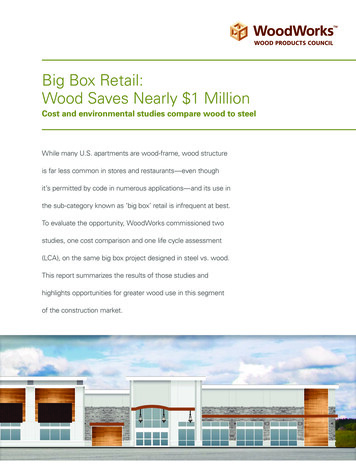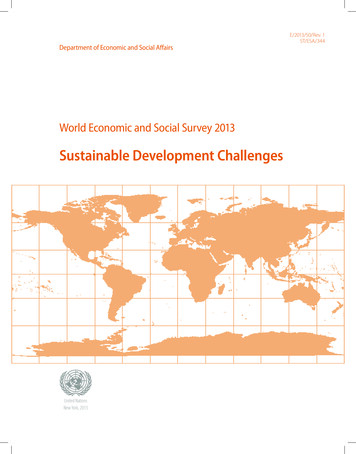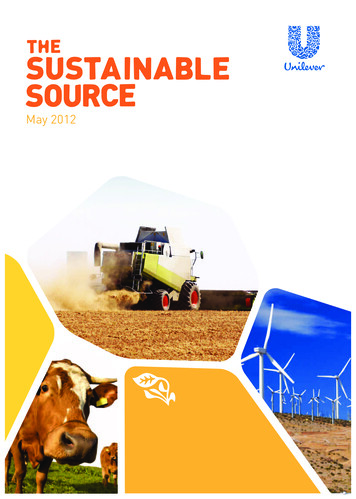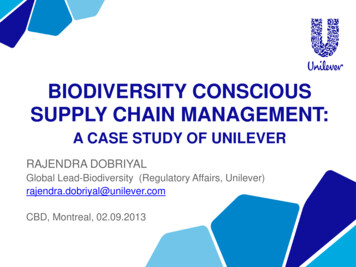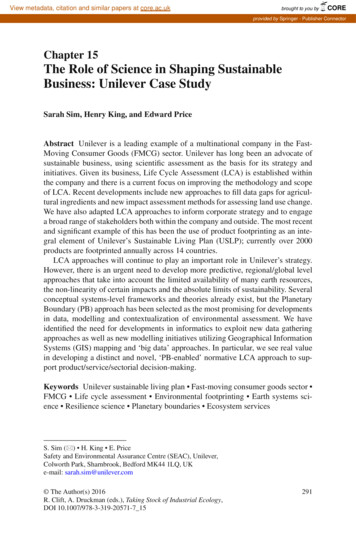
Transcription
May 8, 2013Sustainable Growth:Taking a Deep Dive into WaterGlobal Markets InstituteWater could be a constraint on growthThe world’s freshwater resources are unevenly distributed around theplanet: over 60% of the Earth’s freshwater supply is found in just 10countries. Severe water stress affects 3 billion people, two-thirds ofwhom reside in the BRICs. Water needs are quickly increasing inemerging economies such as China and India, which together accountfor nearly 40% of global population and a third of global waterdemand. Moreover, water resources in many developing countries arebecoming heavily polluted and unsuitable for human use. Inadequatewater resources could be an impediment to growth as developingnations face rapidly growing demand for food and energy.Abby Joseph Cohen, CFA(212) 902-4095 abby.cohen@gs.comGoldman, Sachs & Co.Rachel Siu(212) 357-0493 rachel.siu@gs.comGoldman, Sachs & Co.Growing energy demand drives water useEnergy needs are increasing rapidly in emerging economies and thefuel mix used has a direct impact on water resources. Currently, closeto a third of global energy demand is met by oil, an extremely waterintensive fuel source. Natural gas is a growing alternative to oil, led bythe “shale revolution” in the United States. The extraction ofunconventional gas is water-intensive and an adequate water supply isa critical ingredient in shale production. US shale gas development hasbeen aided by the country’s abundant water resources. In contrast,inadequate water supplies could be a constraint for prospective shaleproducing countries like China and Mexico.Virtual water trade to feed the expanding middle classThe expansion of the middle class in developing countries is expectedto shift dietary preferences from predominantly plant-based foods tomore water-intensive meat and dairy products. To manage thesedietary changes, many water-scarce nations have engaged in “virtualwater” trade, reducing domestic agricultural water use by importingwater-intensive products from water-rich countries.Market opportunities in water risk mitigationMany water-scarce countries have adopted strategies to mitigate waterrisks; for example, the large-scale desalination plants in the MiddleEast and Israel’s treatment and reuse of wastewater for irrigation. Theglobal water industry, which includes sectors like desalination andwater-efficiency technologies, is estimated to total over 300 billion.The Global Markets Institute is the public policy research unit of Goldman Sachs Global Investment Research. Itsmission is to provide research and high-level advisory services to policymakers, regulators and investors aroundthe world. The Institute leverages the expertise of Research and other Goldman Sachs professionals, as well ashighly-regarded thought leaders outside the firm, to offer written analyses and host discussion forums.The Goldman Sachs Group, Inc.Global Investment Research
May 8, 2013Global Markets InstituteTable of ContentsExecutive Summary3Water: a critical resource, unevenly distributed5The uneven global distribution5The water-energy nexus: energy is a growing share of water use9Agriculture remains a significant user of water14The role of virtual water trade15Market opportunities in water risk mitigation18Appendix A: The world’s water supply19Appendix B: Water stress is a rising concern in developing nations20Appendix C: Water withdrawal versus consumption21Appendix D: Building freshwater supply through desalination22Appendix E: Private sector recognizes water risk23Disclosures25Exhibits1. Ten countries possess over 60% of the world’s freshwater supply62. A wide disparity in per capita distribution63. Developing economies have been major drivers of global water demand74. Water withdrawals have increased rapidly in developing countries85. China and India account for one third of worldwide water use86. Agriculture accounts for 70% of the world’s water use97. Production of biofuels has ramped up rapidly in recent years118. Water requirements for power generation vary depending on the fuel source and cooling technology129. Meat production, in particular beef, requires extremely large amounts of water1510. China is the world's largest consumer of pork1611. Freshwater resources make up just 2.5% of the global water supply1912. Close to half of the global population could be living in regions with severe water stress by 20302013. 60% of the additional people in high water stress areas are projected to reside in the BRICs2014. While power generation accounts for 40% of withdrawals 2115. only 3% is consumed21The Goldman Sachs Group, Inc.2
May 8, 2013Global Markets InstituteExecutive SummaryWater: a critical resource, unevenly distributedThe world’s freshwater resources are unevenly distributed around the planet. Over 60% ofthe Earth’s accessible freshwater supply is found in just 10 countries, including Brazil (13%of global resources), Russia (10%), Canada (7%) and the United States (7%). This imbalanceis further evident at the per-capita level. For example, China has roughly the same amountof water as the United States, but it also has four times the US population.As a result of the uneven distribution, an estimated 2.8 billion people currently live in areasunder severe water stress.1 A large percentage of the affected population resides indeveloping countries; in fact, close to two-thirds live in the BRICs (Brazil, Russia, India andChina). Moreover, water needs are rapidly increasing in emerging economies such asChina and India, which together account for nearly 40% of global population and a third ofworldwide water demand. For instance, India alone accounted for more than 30% of theincrease in global water withdrawals2 over the past 15 years.Poor management of resources add to water challengesThe pollution and contamination of water resources pose additional constraints on supply.This is particularly a concern in many developing nations given the lack of adequatewastewater treatment facilities. According to the UN, roughly 90% of all wastewater indeveloping countries is discharged untreated, directly into the sea or rivers. Moreover, therapid rates of urbanization in many emerging economies have outpaced the construction ofsanitation facilities. Further, the emphasis on economic growth has often taken priority toother issues such as maintaining water quality near industrial sites.Scientists believe climate change will increase the frequency of extreme weather eventsand exacerbate the uneven distribution of the global water supply. Arid regions will likelybe the most impacted as water resources become increasingly scarce.Competing for water: the water-energy nexus Inadequate water resources could be an impediment to growth as developing nations facegrowing demand for food and energy. Globally, average electricity generation per capita isprojected to almost double by 2050.3 Water plays a critical role in major steps of energyproduction: extraction, refining and electricity generation. Thus, the fuel mix used to meetthe rising energy demand has a direct impact on water resources.Close to a third of global energy needs is currently met by oil, one of the most waterintensive fuels. The increasing production of unconventional oils (such as heavy oils andoil sands) has significant water implications, as these sources are estimated to consume2.5 to 4 times more water than conventional oil.Natural gas is expected to play a larger role in the global fuel mix, led by the “shalerevolution” in the United States. Because shale gas extraction is relatively water-intensive,1The definition used by the OECD for water stress refers to water withdrawals as a percentage of totalrenewable resource. Below 10% is considered no stress, 10-20% is low stress, 20-40% is medium stressand above 40% is severe stress.2Water withdrawals refer to the amount of water removed from the source, a portion of which canpotentially be reused. In contrast, water consumption refers to the amount that is expended and notavailable for reuse. See Appendix C for a more detailed explanation.3The Goldman Sachs Group, Inc.World Energy Council.3
May 8, 2013Global Markets Institutean adequate water supply is a critical ingredient in shale production. Shale development incountries like Canada and the United States has been aided by abundant domestic waterresources. In contrast, some regions in China that are believed to contain significantamounts of shale gas deposits are located in water-scarce areas.Water also plays an important role in power generation, where it is used in the coolingprocess for thermoelectric plants. When water is withdrawn for cooling power plants, asizable amount can be reused again (though the quality may vary). The reusable quantitydepends on the fuel source and the type of cooling technology employed. Among thermalsources, nuclear energy withdraws the largest amount of cooling water, mainly to maintainthe temperature at the reactor core, though a sizable amount is typically reused.Renewable sources of electricity, such as wind and solar photovoltaic (PV) cells, generallyrequire small amounts of water, mostly for cleaning. and agriculture to feed the growing populationTo feed the growing world population (projected to increase 30% by 2050), the agriculturalsector, currently 70% of global withdrawals, will continue to be a major user of waterresources. The expansion of the middle class in developing nations has a large impact onagricultural water use. The rise in incomes typically results in a shift in dietary preferencesfrom predominantly plant-based diets to more water-intensive dairy and meat products.To meet these dietary changes, many countries, particularly those in water-scarce regions,have engaged in “virtual water” trade. Virtual water refers to the water that is used in theproduction of a good. For example, when a country imports one ton of wheat, it isimporting virtual water—that is, the water needed to produce the crop. Virtual water tradehas been suggested as a way to alleviate the uneven distribution of water by allowing forthe transfer of water resources from water-rich nations to water-scarce countries. It couldalso allow for greater efficiency of water use as virtual water flows from relatively moreefficient countries to less-efficient ones. For example, China imports soy-based productsmainly from three countries, Brazil, the United States and Argentina, which are able toproduce soy with less water than domestic production in China.Water-stressed countries seek to address supply challengesThe number of people impacted by severe water stress is projected to reach 4 billion by2030,4 roughly half the global population. Many countries, especially those in water-scarcegeographies, have adopted strategies to manage water risk, such as the large-scaledesalination plants in the Middle East and Israel’s treatment and reuse of wastewater forirrigation (over 80% of household wastewater is treated and reused for irrigation in Israel,about four times the next-highest rate in the world). As countries seek to address mountingwater challenges, companies have seized on the business opportunity to provide solutions.The global water industry, which is estimated to total over 300 billion,5 includes sectorslike desalination (converting saline water into potable water), wastewater treatment(recycling wastewater to be reused) and water-efficiency technologies.Government efforts to contain demand are complicated given the heavily subsidized watercosts (particularly for agricultural use) in many countries. The low price of water in mostregions of the world makes it challenging to incentivize users, especially those in relativelywater-rich regions, to improve efficiency.The Goldman Sachs Group, Inc.4OECD.5Global Water Intelligence estimates a global market size of 316 billion.4
May 8, 2013Global Markets InstituteWater: a critical resource, unevenly distributedThe uneven global distributionThe world’s waterresources are distributedunevenly around theplanet: over 60% of theglobal supply is found in10 countries.The imbalance is morestrikingly evident at theper capita level.The world’s freshwater resources are distributed unevenly around the planet. NorthAmerica, for example, has an abundance of freshwater, in sharp contrast to regions at theother end of the spectrum such as the arid Middle East. In fact, over 60% of the world’sfreshwater supply is found in 10 countries (see Exhibit 1), notably Brazil (13% of globalresources), Russia (10%), Canada (7%) and the United States (7%).The imbalance is further evident on a per-capita basis (see Exhibit 2). For instance,Canada’s abundance of freshwater resources and its relatively sparse population mean thecountry has close to 85,000m3 of freshwater per person.6 In contrast, China, with 20% of theglobal population, has just roughly 2,000m3 of freshwater per capita, less than 3% ofCanada’s per capita availability.As a result of the uneven global distribution, nearly 3 billion people currently live in areasunder severe water stress.7 A large portion of the affected population resides in developingcountries: close to two-thirds live in the BRICs (Brazil, Russia, India and China). Animbalanced local distribution of resources adds to water strains. For example, some of themajor cities in China, including Beijing, are located in drought-prone regions (see Box ondisparities at the local level).With water needs growing rapidly in emerging economies, the global number of thoseliving under severe water stress is projected to increase by an additional one billion peopleby 2030 to total 3.9 billion. (See Appendix B for further discussion on populations impactedby water stress.)Disparities at the Local LevelLarge disparities also exist within a country’s borders. For example, the United States isrelatively water abundant in absolute terms but there are significant regional differences:the Southwest region of the country is arid and drought-prone, while the Northeast andMidwest areas have more precipitation and access to the Great Lakes (which make up thelargest surface freshwater system on Earth). Another example is China: precipitation andgroundwater supplies are concentrated in the South, whereas the Northern part of thecountry is drought-prone. The Chinese government is attempting to address this unevendistribution through the ambitious 60 billion South-to-North water transfer project, whichaims to divert water from the Yangtze River to drier regions in the North, where majorcities like Beijing and Tianjin are located. Construction for the project is ongoing, with oneroute scheduled to begin transferring water starting in 2014. It has been a controversialproject due to its environmental impact in some areas.6Per capita freshwater resources include internal renewable resources such as river flows andgroundwater from rainfall (World Bank definition). See Appendix A for further discussion on globalwater resources.7The definition used by the OECD for water stress refers to water withdrawals as a percentage of totalrenewable resource. Below 10% is considered no stress, 10-20% is low stress, 20-40% is medium stressand above 40% is severe stress.The Goldman Sachs Group, Inc.5
May 8, 2013Global Markets InstituteExhibit 1: Ten countries possess over 60% of the world’s freshwater supplyGeographic breakdown of global freshwater resources, 2009 dataBrazil13%Russia10%Rest of World38%Canada7%US7%Myanmar2%India3%Peru Indonesia4%5%Colombia5%China6%Source: World Bank.Exhibit 2: A wide disparity in per capita distributionPer capita freshwater resources, 2009 data90,00084,495More abundantLess abundant80,000Per capita freshwater resources (cubic 97616EUUKChinaIndiaMiddle East& aranAfricaJapanSource: World Bank.The Goldman Sachs Group, Inc.6
May 8, 2013Global Markets InstituteGrowing demand contributes to water stressThe rising water needsin developing economiesintensify scarcityconcerns.Water use in developing countries has increased rapidly over the past fifteen years. Since1997, water withdrawals have increased by 81% in Vietnam, 52% in India and 43% inMexico. See Exhibit 4. Today, China and India account for a third of global water demand(see Exhibit 5). In contrast, water withdrawals in developed economies like the UnitedStates and Japan have stayed relatively constant.One key distinction is between water withdrawals versus consumption: water withdrawalsrefer to the amount of water removed from the source, a portion of which can potentiallybe reused. This is different from water consumption, which refers to the amount that isexpended and not available for reuse. International data tend to focus on withdrawals. (SeeAppendix C for a more detailed discussion.)Exhibit 3: Developing economies have been major drivers of global water demandBreakdown of global freshwater withdrawalsAnnual water withdrawals (billion cubic t ofWorld2,500Rest ofWorldRest ofWorldRest 9972002200720110Source: World Bank.The Goldman Sachs Group, Inc.7
May 8, 2013Global Markets InstituteExhibit 4: Water withdrawals have increased rapidly indeveloping countriesExhibit 5: China and India account for one third ofworldwide water usePercentage change in total water withdrawals in selectednations, between 1997 and 2011Breakdown of global withdrawals90%Developingcountries81%% change in water withdrawals since 6%‐2%‐10%VietnamIndonesiaIndiaMexicoSource: World Bank.PakistanEUSource: World Bank.Pollution and climate change pose additional challengesIn many developingcountries, pollutionposes an additionalconstraint on supply The water challenges faced by many developing nations are compounded by the poormanagement of resources. Pollution is a major concern in many emerging countries due tothe lack of adequate wastewater treatment facilities. According to the UN, roughly 90% ofall wastewater in developing countries is discharged untreated, directly into the sea orrivers. Rapid urbanization in developing economies has also contributed to pollution, asthe growth in the urban population has outpaced the development of sanitation facilities.UN statistics indicate that close to 800 million city dwellers—over 20% of global urbanpopulation—lack access to sanitation facilities (i.e., facilities that ensure hygienicseparation of human waste from human contact). as many waterresources have becomeheavily contaminatedand unsuitable forhuman consumption.Heavy contamination can pose serious constraints on supply. In China, for instance, resultsfrom a recent survey by the country’s Ministry of Land and Resources indicate only 22% ofthe groundwater in the northern provinces was suitable for human contact.8 More thanClimate change andextreme weather eventsmake watermanagement even morechallenging.half of the groundwater supply was found to be unsuitable for either industrial use orhuman consumption.This scenario is further complicated by extreme weather events and climate change.Extreme weather events, such as floods and droughts (including the recent severedroughts in the United States), add to the unpredictability of water availability and makewater management even more challenging. Scientists believe climate change will increasethe frequency of extreme weather events and exacerbate the uneven distribution of theglobal water supply. Arid regions will likely be the most impacted as water resourcesbecome increasingly scarce.Competition for water on the riseWater demand, particularly in emerging economies, is expected to continue on an upwardtrajectory. The growing global population (projected to total roughly 9 billion by 2050)means that the need for food, energy, and consequently water, will only increase.Inadequate water resources to meet these needs could be an impediment to growth,particularly in developing nations. We address water use in energy and agriculture in thefollowing section.8The Goldman Sachs Group, Inc.China Water Risk, “North China Plain ground water: 70% unfit for human touch,” February 2013.8
May 8, 2013Global Markets InstituteCompeting for waterAgriculture is currentlythe largest user ofwater, but it faces risingcompetition forresources from theindustrial sector.Agriculture is currently the largest user of water, accounting for about 70% of global waterwithdrawals. However, this share is projected to decline from 70% to 65%,9 as theproportion of withdrawals from industrial activity is expected to grow. This rising demandin industrial water use is driven by growing energy needs in emerging economies likeChina.Exhibit 6: Agriculture accounts for 70% of the world’s water useBreakdown of global freshwater withdrawals, 2009 dataDomestic, 11.7%Industry, 18.1%Agriculture, 70.2%Source: World Bank.The water-energy nexus: energy is a growing share of water useWater plays a criticalrole in the energy sector.The growth of the urban, middle class in developing countries is expected to drive demandfor energy. The average electricity generation per capita is projected to almost double from2.9 MWh per person to 5.7 MWh per person by 2050.10 Water plays an integral role in theenergy sector, as it is required throughout the process, from extraction to refining andproduction to electricity generation. On the flip side, energy is also required for thetreatment and transport of water, for instance, for pumping groundwater reserves or fordesalination plants. The fuel mix used to meet the growing energy demand will have adirect impact on the water sector.92030 Water Resources Group.10The Goldman Sachs Group, Inc.World Energy Council, “Water for Energy,” 2010.9
May 8, 2013Global Markets InstituteFor primary fuel production, water consumption varies vastly by source.Among fossil fuels, theproduction of crude oiltends to require thelargest amounts ofwater.Coal production is lesswater-intensive than oil,but the process oftenproduces vast amountsof waste fluids that mustbe stored. Crude oil: Oil accounts for roughly a third of global fuel consumption. It also requiresamong the highest levels of water in its production process (on average 1.058m3 perGJ of energy).11 Unconventional oils (such as heavy oils and oil sands) are becominglarger parts of the energy mix, especially in North America, and they consume anestimated 2.5 to 4 times more water than conventional oil sources. These large waterrequirements can pose challenges for many of the world’s major oil producers as thesecountries have an abundance of oil reserves but limited supplies of water. Coal: Coal is another major fuel source, accounting for 30% of global energy use. Theproduction of coal is less water-intensive than crude oil, averaging 0.164m3 per GJ12(roughly 15% of the requirement for conventional oil). However, because water ismainly used in the process of removing impurities from coal, large volumes of wastefluid are produced. This waste product cannot be reused and must be stored, posingenvironmental risks if the impoundments fail (i.e., potential contamination ofgroundwater supplies). Although this report does not directly cover the broaderenvironmental impact of coal, it should be noted that coal is generally considered to bea “dirty” energy source both in terms of carbon footprint and particulate emissions.In China, where there are vast coal reserves, about 70% of the country’s energy needsare met by coal.13 As a result, the coal industry represents a significant portion of thecountry’s water use, accounting for 15% of total withdrawals in 2010.The extraction of shalegas is estimated torequire many times theamount of water neededfor conventional gas. Natural gas: Natural gas makes up a quarter of worldwide fuel consumption but thispercentage, led by the “shale revolution” in the United States, is expected to increasedramatically in the future. While the extraction of conventional natural gas involves thelowest water consumption among fossil fuels (roughly 0.109m3 per GJ),14 shale gasextraction is estimated to require many times the water needed in conventional gasdevelopment. Conventional (vertical) drilling requires on average between 20,000 to80,000 gallons of water per well while unconventional (horizontal) drilling can usebetween 2 to 9 million gallons of water per well.15In relatively water-rich countries like Canada and the United States, the abundance ofdomestic water resources has helped facilitate the development of unconventional gas.In contrast, inadequate water supplies could be a constraint for prospective shaleproducing countries like Mexico and China. For instance, some regions in China thatare believed to contain significant amounts of shale gas deposits are located in waterscarce areas. Another major concern that has arisen with the expanded use ofhydraulic fracturing is the risk of contaminating water supplies that are used for otherpurposes.11World Energy Council, “Water for Energy,” 2010.12Ibid.13For additional GMI analysis on China’s energy use, see “Sustainable Growth in China: Spotlight onEnergy,” August 2012.The Goldman Sachs Group, Inc.14World Energy Council, “Water for Energy,” 2010.15Siemens, “Will horizontal wells become conventional in oil and gas?,” January 2013.10
May 8, 2013Biofuels are consideredan alternative energysource to fossil fuels.Global Markets Institute Biofuels: Biofuels, produced from crops such as maize and sugarcane, is an alternativesource that can help meet the growing global energy demand. Global production ofbiofuels has ramped up rapidly, increasing close to 200% since 2005 (see Exhibit 7). Inparticular, China, which has encouraged the development of the biofuels industry,increased its production levels from essentially zero in 2001 to 23 thousand barrels perday in 2011. This is still a small number compared to countries like Brazil (265thousand barrels daily) and the United States (567 thousand barrels daily) but Chineseproduction levels are expected to increase.However, the use of crops as raw materials increases the competition for foodresources and consequently for water. The ongoing development of alternative nonfood sources, such as switchgrass, Jatropha and algae, will be critical in order forbiofuels to become a viable, sustainable energy source.But the use of crops asraw materials increasesthe competition for foodand water.Exhibit 7: Production of biofuels has ramped up rapidly in recent yearsGlobal biofuels production, breakdown by geography1,400thousand barrels per day1,2001,00080060040020001990 1992 1994 1996 1998 2000 2002 2004 2006 2008 2010North AmericaSouth and Central AmericaRest of WorldSource: BP Statistical Review of World Energy 2012.Cooling water for electricity generationPower plants mainly usewater for cooling.A sizable amount of thecooling water canusually be reused.Water also plays an important role in electricity generation, where it is used mainly in thecooling process for thermoelectric plants.16 When water is withdrawn for cooling electricplants, a sizable amount can typically be reused. The gap between the amount of waterwithdrawn (i.e., the amount removed from the water source) and the amount of waterconsumed (i.e., the amount expended and not available for reuse) varies depending on thefuel type and on the cooling technology employed. These two factors are key determinantsin how much water is available for reuse.16Thermoelectric plants (which use traditional fossil fuels like coal, natural gas and oil) generateelectricity by boiling water to create the steam that drives turbines. After the steam passes through theturbines, it is cooled, allowing it to condense and be reused. The bulk of the water use by power plantstakes place during this cooling process and a sizable amount can typically be reused.The Goldman Sachs Group, Inc.11
May 8, 2013The amount of wateravailable for reusedepends on the fuelsource and the coolingtechnology employed.Global Markets InstituteThere are three main cooling technologies (see Exhibit 8 for additional detail): Once-through cooling: a large amount of cooling water (usually from a nearby bodyof water) is withdrawn and used once before most of it is discharged back to thesource, albeit at a higher temperature. Thus, while an enormous amount of water iswithdrawn, the volume of water consumed tends to be quite low. Recirculating cooling: these systems use the same water repeatedly during thecooling process. Compared to once-through cooling systems, recirculating coolingtechnologies take in less water but they tend to consume much more because a largepercentage of water evaporates during the process. Nuclear plants tend towithdraw and consumethe largest amounts ofwater, while renewablesrequire small amountsfor cleaning.Dry cooling: almost no water is used as the cooling is done by air. This technology isnot commonly used as it is generally more expensive and more energy-intensive thanthe once-through and recirculating cooling systems.The table in Exhibit 8 summarizes the amount of water used during electricity generation,broken down by various fuel types and the cooling technology employed. Among the mostcommon fuel sources, nuclear plants on average withdraw and consume the most water,followed by coal-fired plants. Given the required cooling process for thermoelectric plants,it is not surprising that thermal sources require much larger amounts of water thanrenewable sources. Renewable fuels, such as solar photovoltaic (PV) and wind, use smallamounts of water, mostly for cleaning.Exhibit 8: Water requirements for power generation vary depe
Executive Summary Water: a critical resource, unevenly distributed The world's freshwater resources are unevenly distributed around the planet. Over 60% of the Earth's accessible freshwater supply is found in just 10 countries, including Brazil (13% of global resources), Russia (10%), Canada (7%) and the United States (7%). This imbalance






